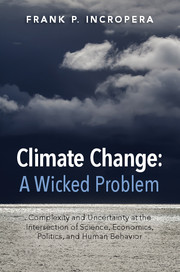 Climate Change: A Wicked Problem
Climate Change: A Wicked Problem Book contents
- Frontmatter
- Dedication
- Contents
- Foreword by Anthony F. Earley Jr.
- Foreword by G.P. “Bud” Peterson
- Foreword by Arun Majumdar
- Preface
- Acknowledgments
- Abbreviations
- 1 Energy, economics, and climate change
- 2 The Earth's climate system
- 3 Greenhouse gases
- 4 Global warming
- 5 Consequences of global warming
- 6 Mitigation, adaptation, and geoengineering
- 7 Public policy options
- 8 The politics of global warming: a history lesson and future prospects
- 9 Dissenting opinions: the great hoax
- 10 The ethics of climate change
- 11 A way forward
- Appendix A Units and conversion factors
- Appendix B Fossil fuels
- Appendix C Anthropogenic sources of natural gas and methane
- Appendix D Environmental time scales and inertia
- Appendix E Coal-fired power plants: operating conditions and costs of carbon capture and sequestration
- Notes
- References
- Index
- Plate section
Preface
Published online by Cambridge University Press: 05 October 2015
- Frontmatter
- Dedication
- Contents
- Foreword by Anthony F. Earley Jr.
- Foreword by G.P. “Bud” Peterson
- Foreword by Arun Majumdar
- Preface
- Acknowledgments
- Abbreviations
- 1 Energy, economics, and climate change
- 2 The Earth's climate system
- 3 Greenhouse gases
- 4 Global warming
- 5 Consequences of global warming
- 6 Mitigation, adaptation, and geoengineering
- 7 Public policy options
- 8 The politics of global warming: a history lesson and future prospects
- 9 Dissenting opinions: the great hoax
- 10 The ethics of climate change
- 11 A way forward
- Appendix A Units and conversion factors
- Appendix B Fossil fuels
- Appendix C Anthropogenic sources of natural gas and methane
- Appendix D Environmental time scales and inertia
- Appendix E Coal-fired power plants: operating conditions and costs of carbon capture and sequestration
- Notes
- References
- Index
- Plate section
Summary
To state the obvious, climate change is an environmental problem. But it has features that distinguish it from other well-publicized problems. For one, competing agents create uncertainty in linkages between cause and effect. With other environmental problems, deleterious effects are due solely to anthropogenic activities. There are no other agents. It is well known that automotive and power plant emissions such as carbon monoxide, sulfur dioxide, and particulates adversely affect human health and the environment. The same can be said of refrigerants that deplete stratospheric ozone. However, for climate change, anthropogenic agents associated with emissions of greenhouse gases such as carbon dioxide are superimposed on natural causes, and distinguishing between their effects is not a trivial matter.
Another distinguishing feature deals with time scales. For other environmental problems, adverse effects are near-term, if not immediate. In contrast, significant inertia is associated with the long residence time of atmospheric greenhouse gases and the slow rate at which equilibrium is achieved between the Earth's atmosphere and oceans. The effects of today's emissions are not felt today but over time, and it may be decades before they are unequivocally revealed. Lastly, unlike many environmental problems, climate change is not a regional or national problem. It is global.
The foregoing features make climate change a uniquely challenging environmental problem. But there's more. Four decades ago, Rittel and Webber (1973) introduced the notion of a wicked problem. Wicked problems are inherently societal problems, and in pluralistic societies with diverse interests and traditions there is seldom consensus on the nature of the problem, much less its solution. A wicked problem has many stakeholders, and any attempt at a solution has multiple consequences as its implications ripple across the many affected parties. Whether the solution is right or wrong is not judged by absolute or objective standards but by the interests and values of the stakeholders. Climate change, or more specifically anthropogenic climate change, is a prototypical wicked problem.
By integrating a comprehensive set of relevant factors, this book is intended to inform the climate change debate in ways that recognize existing uncertainties and tensions, as well as limitations to achieving timely and meaningful solutions. Drawing on the most recent literature, the underlying science is treated in depth.
- Type
- Chapter
- Information
- Climate Change: A Wicked ProblemComplexity and Uncertainty at the Intersection of Science, Economics, Politics, and Human Behavior, pp. xxi - xxviPublisher: Cambridge University PressPrint publication year: 2015
